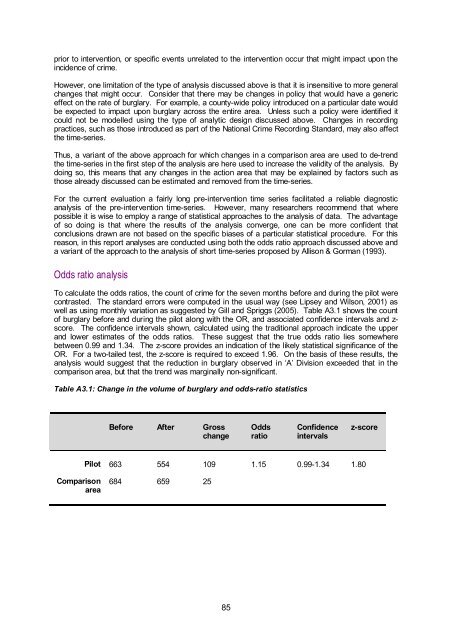Prospective crime mapping in operational context Final report
Prospective crime mapping in operational context Final report
Prospective crime mapping in operational context Final report
- No tags were found...
You also want an ePaper? Increase the reach of your titles
YUMPU automatically turns print PDFs into web optimized ePapers that Google loves.
prior to <strong>in</strong>tervention, or specific events unrelated to the <strong>in</strong>tervention occur that might impact upon the<strong>in</strong>cidence of <strong>crime</strong>.However, one limitation of the type of analysis discussed above is that it is <strong>in</strong>sensitive to more generalchanges that might occur. Consider that there may be changes <strong>in</strong> policy that would have a genericeffect on the rate of burglary. For example, a county-wide policy <strong>in</strong>troduced on a particular date wouldbe expected to impact upon burglary across the entire area. Unless such a policy were identified itcould not be modelled us<strong>in</strong>g the type of analytic design discussed above. Changes <strong>in</strong> record<strong>in</strong>gpractices, such as those <strong>in</strong>troduced as part of the National Crime Record<strong>in</strong>g Standard, may also affectthe time-series.Thus, a variant of the above approach for which changes <strong>in</strong> a comparison area are used to de-trendthe time-series <strong>in</strong> the first step of the analysis are here used to <strong>in</strong>crease the validity of the analysis. Bydo<strong>in</strong>g so, this means that any changes <strong>in</strong> the action area that may be expla<strong>in</strong>ed by factors such asthose already discussed can be estimated and removed from the time-series.For the current evaluation a fairly long pre-<strong>in</strong>tervention time series facilitated a reliable diagnosticanalysis of the pre-<strong>in</strong>tervention time-series. However, many researchers recommend that wherepossible it is wise to employ a range of statistical approaches to the analysis of data. The advantageof so do<strong>in</strong>g is that where the results of the analysis converge, one can be more confident thatconclusions drawn are not based on the specific biases of a particular statistical procedure. For thisreason, <strong>in</strong> this <strong>report</strong> analyses are conducted us<strong>in</strong>g both the odds ratio approach discussed above anda variant of the approach to the analysis of short time-series proposed by Allison & Gorman (1993).Odds ratio analysisTo calculate the odds ratios, the count of <strong>crime</strong> for the seven months before and dur<strong>in</strong>g the pilot werecontrasted. The standard errors were computed <strong>in</strong> the usual way (see Lipsey and Wilson, 2001) aswell as us<strong>in</strong>g monthly variation as suggested by Gill and Spriggs (2005). Table A3.1 shows the countof burglary before and dur<strong>in</strong>g the pilot along with the OR, and associated confidence <strong>in</strong>tervals and z-score. The confidence <strong>in</strong>tervals shown, calculated us<strong>in</strong>g the traditional approach <strong>in</strong>dicate the upperand lower estimates of the odds ratios. These suggest that the true odds ratio lies somewherebetween 0.99 and 1.34. The z-score provides an <strong>in</strong>dication of the likely statistical significance of theOR. For a two-tailed test, the z-score is required to exceed 1.96. On the basis of these results, theanalysis would suggest that the reduction <strong>in</strong> burglary observed <strong>in</strong> ‘A’ Division exceeded that <strong>in</strong> thecomparison area, but that the trend was marg<strong>in</strong>ally non-significant.Table A3.1: Change <strong>in</strong> the volume of burglary and odds-ratio statisticsBefore After GrosschangeOddsratioConfidence<strong>in</strong>tervalsz-scorePilot 663 554 109 1.15 0.99-1.34 1.80Comparisonarea684 659 2585
















